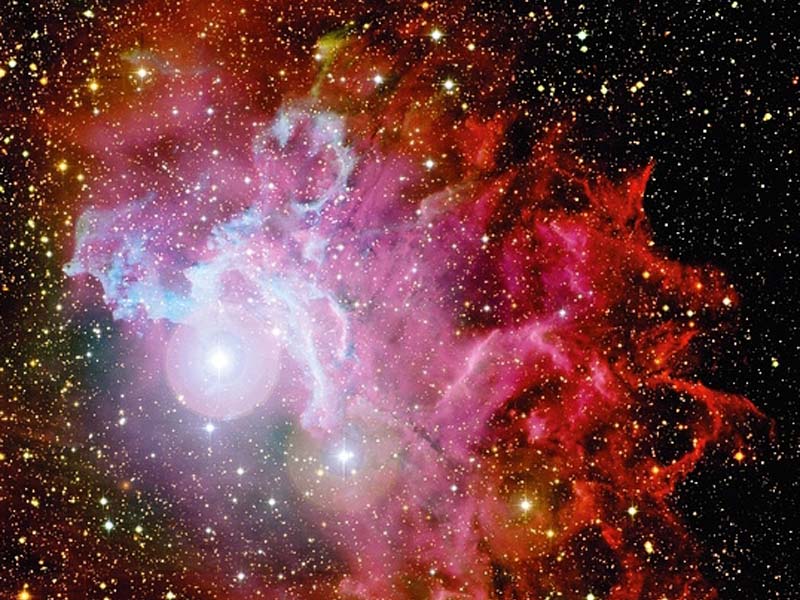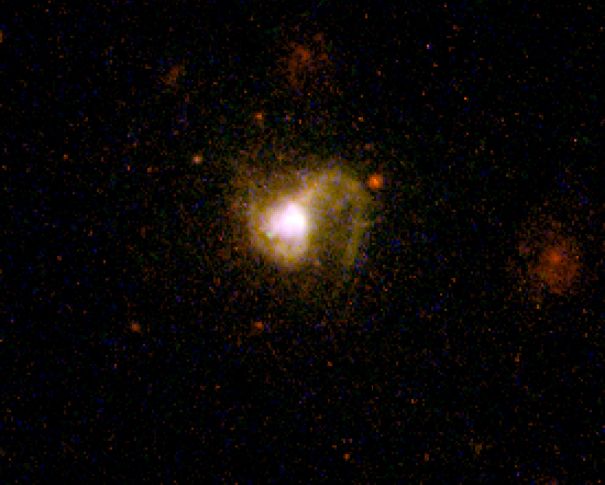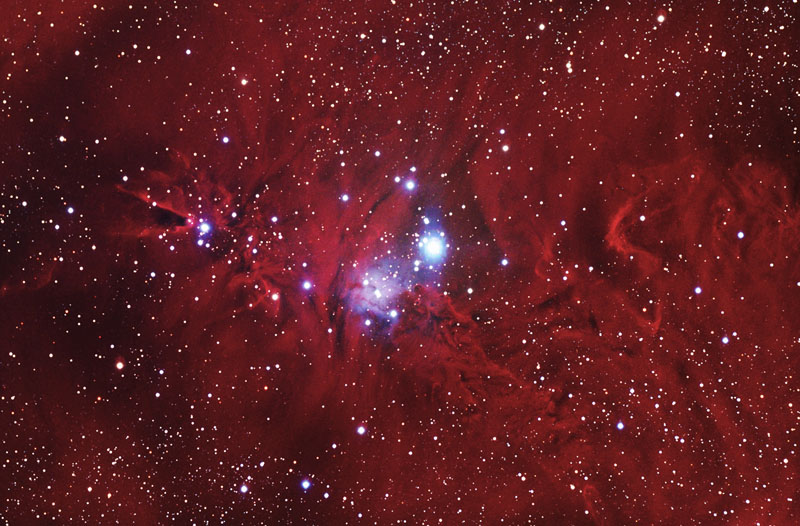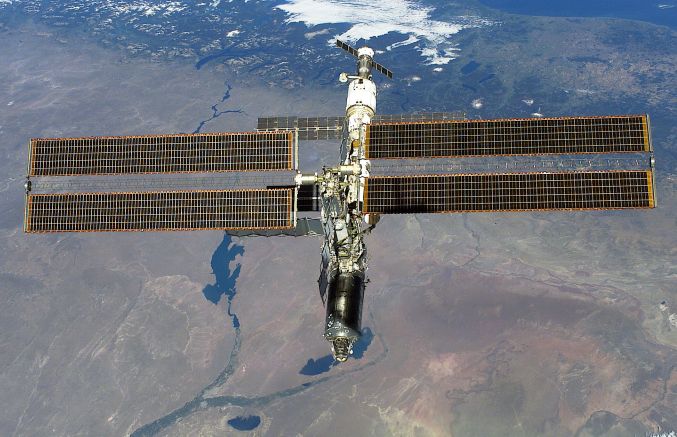| << Previous | Index | Next >> |
2015Taken on February 20, five different exposures made in rapid succession were used to created this tantalizing telephoto image. In combination, they reveal a wide range of brightness visible to the eye on that frigid evening, from the urban glow of the Quebec City skyline to the triple conjunction of Moon, Venus and Mars. Shortly after sunset the young Moon shows off its bright crescent next to brilliant Venus. Fainter Mars is near the top of the frame. Though details in the Moon's sunlit crescent are washed out, features on the dark, shadowed part of the lunar disk are remarkably clear. Still lacking city lights the lunar night is illuminated solely by earthshine, light reflected from the sunlit side of planet Earth.
2014 Only two days past full, February's moon shines through thin clouds, rising on the left in this fisheye night skyscape. The moonlight illuminates a weathered, rounded foreground in the Alabama Hills, conveniently located east of Mt. Whitney along the Sierra Nevada range in California, USA, planet Earth. Orion the Hunter stands at the right, a familiar northern winter constellation. Bright Jupiter, the solar system's ruling gas giant, is near center at the top of the frame. Below Jupiter, Sirius, alpha star of the Big Dog, poses above a bowed and twisted landform known as Möbius Arch, its curve reminiscent of the mathematically famous surface with only one side. Of course, instead of using rock, wind, and weather, a Möbius strip is easier to make with paper, scissors, and tape.
2013 The alarmingly tall inhabitants of this small, snowy planet cast long shadows in bright moonlight. Of course, the snowy planet is actually planet Earth and the wide-angle mosaic, shown as a little planet projection, was recorded on February 25 during the long northern night of the Full Snow Moon. The second brightest celestial beacon is Jupiter, on the right above the little planet's horizon. Lights near Östersund, Sweden glow along the horizon, surrounding the snow covered lake Storsjön. The photographer reports that the journey out onto the frozen lake by sled to capture the evocative Full Snow Moon scene was accompanied by ice sounds, biting cold, and a moonlit mist.
2012 Why does Comet Garradd have two tails? Visible on the left, Comet Garradd's dust tail is composed of ice and dust bits that trail the comet in its orbit around the Sun. Visible on the right, Comet Garradd's ion tail, is composed of ionized gas blown directly out from the Sun by the solar wind. Most comets show two tails, although it is unusual for them to appear to point in nearly opposite directions. Comet Garradd is currently showing opposing tails because of the Earth's opportunistic intermediate viewing angle. Subtle hues in the above image captured last week show the dust tail as slightly yellow as its large grains reflecting sunlight achromatically, while the ion tail shines slightly blue as the carbon monoxide ions reflect blue sunlight more efficiently. In the center, surrounding the comet's nucleus, is the green-tinted coma, so colored as it is a mix of dust and gasses that include green-emitting cyanogen. Although now drifting out from the Sun, Comet Garradd will make its closest approach to the Earth next week.
2011 What's hovering between those buildings? The Moon. The above image was taken two weeks ago as the full Snow Moon started to rise above Edmonton, Alberta, Canada. The odd coincidence between the angular size of the far distant Moon and the angular width of nearby buildings created a striking juxtaposition. Backing away from the buildings so to reduce their angular size was a key to planning the image. The temperature was so low, -25 C, that plumes of steam rose from neighboring oil refineries. The above image was taken during a momentary break in the plumes. The rising Moon appears red here for the same reason that a setting Sun appears red -- because blue light is preferentially scattered away by intervening air. In this case, the shimmering steam plumes likely also caused the Moon to appear slightly compressed. The next full moon, the full Worm Moon, will occur in mid-March.
2010 Why doesn't matter just bunch up? The same principle that keeps neutron stars and white dwarf stars from imploding also keeps people from imploding and makes normal matter mostly empty space. The observed reason is known as the Pauli Exclusion Principle. The principle states that identical fermions -- one type of fundamental matter -- cannot be in the same place at the same time and with the same orientation. The other type of matter, bosons, do not have this property, as demonstrated clearly by recently created Bose-Einstein condensates. Earlier this decade, the Pauli Exclusion Principle was demonstrated graphically in the above picture of clouds of two isotopes of lithium -- the left cloud composed of bosons while the right cloud is composed of fermions. As temperature drops, the bosons bunch together, while the fermions better keep their distance. The reason why the Pauli Exclusion Principle is true and the physical limits of the principle are still unknown.
2009 Distorted galaxy NGC 2442 can be found in the southern constellation of the flying fish, (Piscis) Volans. Located about 50 million light-years away, the galaxy's two spiral arms extending from a pronounced central bar give it a hook-shaped appearance. This deep color image also shows the arms' obscuring dust lanes, young blue star clusters and reddish star forming regions surrounding a core of yellowish light from an older population of stars. But the star forming regions seem more concentrated along the drawn-out (right side) spiral arm. The distorted structure is likely the result of an ancient close encounter with the smaller galaxy seen near the top left of this field of view. The two interacting galaxies are separated by about 150,000 light-years at the estimated distance of NGC 2442.
2008 Orbiting 400,000 kilometers above the Earth, the Moon slid into Earth's shadow to begin last week's total lunar eclipse. Of course the International Space Station (ISS) slides into Earth's shadow every 90 minutes, the time it takes it to complete one orbit at an altitude of about 400 kilometers. Recorded near sunset on February 7, looking toward the north, this composite of 70 exposures shows the trail of the ISS (with gaps between exposures) as it moved left to right over the city of Tübingen in southern Germany. Beginning in sunlight on the left, the ISS vanishes as it enters Earth's shadow at the far right, above the northeastern horizon. As seen from Tübingen, the passage took about 4 minutes. A time-lapse animation based on the individual exposures that includes a plane flying along the horizon can be found here.
2007 When stars form, pandemonium reigns. A textbook case is the star forming region NGC 2170. Visible above are red glowing emission nebulas of hydrogen, blue reflection nebulas of dust, dark absorption nebulas of dust, and the stars that formed from them. The first massive stars formed from the dense gas will emit energetic light and winds that erode, fragment, and sculpt their birthplace. And then they explode. The resulting morass is often as beautiful as it is complex. After tens of millions of years, the dust boils away, the gas gets swept away, and all that is left is a naked open cluster of stars.
2006
2005 What are those unusual plates on Mars? A leading current interpretation holds that they are blocks of ice floating on a recently frozen sea covered by dust. The unusual plates were photographed recently by the European Space Agency's Mars Express spacecraft currently orbiting Mars. Oddly, the region lies near the Martian equator and not near either of Mars' frozen polar caps. Without being covered by dust, any water or ice near away from the poles would quickly evaporate right into the atmosphere. Evidence that the above-imaged plates really are dust-covered water-ice includes a similarity in appearance to ice blocks off Earth's Antarctica, nearby surface fractures from which underground water could have flowed, and the shallow depth of the craters indicating that something is filling them in. If correct, the low abundance of craters indicates that water may have flowed on Mars as recently as five million years ago.
2004 Not so long ago and not so far, far away, a galaxy was born. Seen in this Hubble Space Telescope image, the island universe of stars, gas, and dust cataloged as POX 186 is a mere 68 million light-years distant toward an uncrowded region in the constellation Virgo. POX 186 is truly dwarfed by galaxies like our own Milky Way. The diminutive galaxy is about 900 light-years across with around 10 million stars, compared to the Milky Way's 100,000 light-year span and more than 200 billion stars. Cosmically speaking, POX 186 is also very young as the Hubble snapshot reveals a disturbed galaxy that is likely the result of a 100 million year old collision between two even smaller star systems. In fact, POX 186 observations suggest that such isolated, small galaxies may be the last to form, since the most massive galaxies in the universe seem to have formed billions of years ago.
2003 Glowing hydrogen gas fills this gorgeously detailed sky view centered on the variable star S Mon in the faint but fanciful constellation Monoceros, the Unicorn. A star forming region (NGC 2264), the complex jumble of cosmic gas and dust is about 2,700 light-years distant and mixes reddish emission nebulae excited by energetic light from newborn stars with dark interstellar dust clouds. Where the otherwise obscuring dust clouds lie close to stars they also reflect starlight, forming blue reflection nebulae. The wide vista spans about 1.5 degrees or nearly 3 full moons, covering 70 light-years at the distance of NGC 2264. Its cast of cosmic characters includes the Cone Nebula (far left), the Fox Fur Nebula, whose convoluted pelt lies just below S Mon, and the Christmas Tree star cluster. The triangular Christmas Tree cluster appears sideways here, with its apex at the Cone Nebula and its broader base centered on S Mon.
2002 Modern astronomers keep a long list of things that go bump in the night. Near the top are supernovae - the death explosions of massive stars, and gamma-ray bursts - the most powerful explosions seen across the Universe. Intriguingly, the galaxy in the above Hubble Space Telescope image may have been host to both a supernova and a gamma-ray burst which were one and the same event. ESO 184-G82 is a spiral galaxy with a prominent central bar and loose spiral arms dotted with bright star-forming regions. The inset shows an expanded view of one of the star-forming regions, about 300 light-years across. Indicated is the location of an extraordinarily powerful supernova explosion whose light first reached planet Earth on April 25, 1998. That location and date also correspond to the detection of an unusual gamma-ray burst, which may be representative of a peculiar class of these cosmic high-energy flashes. So far, this combination is unique and makes barred spiral ESO 184-G82, at a distance of only 100 million light-years, the closest known gamma-ray burst host galaxy.
2001 The International Space Station (ISS) had a date with Destiny earlier this month. More specifically, the crew of the Space Shuttle Atlantis installed the science laboratory named Destiny on the ISS. Destiny, pictured here, will also serve as a control center for the Earth orbiting space station. To help install this module, space shuttle astronauts conducted the 100th space walk by an American, an event that occurred nearly 40 years after Ed White first ventured outside of his Gemini 4 spacecraft. The space shuttle's crew took the above picture after their spacecraft had undocked from the space station. Over two hundred kilometers below lies the Rio Negro region of Argentina.
2000 Why does the Sombrero Galaxy look like a hat? Reasons include the Sombrero's unusually large and extended central bulge of stars, and dark prominent dust lanes that appear in a disk that we see nearly edge-on. Billions of old stars cause the diffuse glow of the extended central bulge. Close inspection of the bulge in the above photograph shows many points of light that are actually globular clusters. M104's spectacular dust rings harbor many younger and brighter stars, and show intricate details astronomers don't yet fully understand. The very center of the Sombrero glows across the electromagnetic spectrum, and is thought to house a large black hole. Fifty million-year-old light from the Sombrero Galaxy can be seen with a small telescope towards the constellation of Virgo.
1999 Sometimes the unexpected comes in a familiar shape. In this picture, the seemingly familiar teardrop-shaped object just right of center is actually an unusually situated disk of gas and dust. In fact, the teardrop is about the size of our own Solar System and is racing against time to condense and form planets. This disk, however, is unfortunate enough to lie in the Trapezium, which is also home to several immense, bright stars. These bright stars emit light so powerful it boils away the gas and dust in planet-forming disks. Large Jupiter-like planets will probably never form in this hostile environment, but it is currently unknown whether Earth-like planets could form and survive.
1998 Star forming regions known as "EGGs" are uncovered at the end of this giant pillar of gas and dust in the Eagle Nebula (M16). EGGs, short for evaporating gaseous globules, are dense regions of mostly molecular hydrogen gas that fragment and gravitationally collapse to form stars. Light from the hottest and brightest of these new stars heats the end of the pillar and causes further evaporation of gas - revealing yet more EGGs and more young stars. This picture was taken by the Wide Field and Planetary Camera on board the Hubble Space Telescope.
1997 Is our Galaxy this thin? We believe so. The Milky Way, like NGC 891 pictured above, has the width of a typical spiral galaxy. Spirals have most of their bright stars, gas, and obscuring dust in a thin disk. This disk can be so thin the spiral galaxy appears edge-on like a compact disk seen sideways. The dark band across the middle is a lane of dust which absorbs light. Some of the billions of stars that orbit the center of NGC 891, however, appear to be moving too fast to just be traveling in circles. What causes this peculiar motion? One hypothesis is that NGC 891 has a large bar across its center - a bar that would be obvious were we to see this galaxy face-on instead of edge-on. This false color picture was constructed from 3 near infrared images.
1996 Tremendous explosions near the center of our Galaxy were discovered just this past December and are being announced today by a paper in Nature and a press conference at NASA. Bursts like these have never been seen before, and so the exact cause is unknown and will likely be the source of astronomical speculations and observations for years to come. Much more powerful than any explosions we humans can create, these eruptions likely involve the extreme conditions found only on the surface of a neutron star in a binary system, possibly similar to the X-ray binary system depicted in the above drawing. The new source, dubbed GRO J1744-28 for its discovery spacecraft and position, currently produces multiple pulsed bursts of energy per day, each of which last several seconds. The bursts are quite prominent in X-ray light. Discovery team leaders include Chryssa Kouveliotou (USRA) and Gerald Fishman (NASA /MSFC).
| << Previous | Index | Next >> |



















